You must have faced a slow website experience once a while in a day. Out of frustration you immediately look for alternative options on the SERPs.
From the website owner’s point of view, it can be a disastrous situation. High bouncing rates can ultimately negatively affect your SEO.
No matter how well you have hosted your website on the fastest dedicated servers, you cannot solely rely on them. Since the Web’s large network with trillions of users accessing millions of websites, it can cause congestion in the network and hence slow down your website.
Fortunately, like every problem, there is a solution for that, and the same applies here too. Behold the power of CDN, or Content Delivery Network.”
Let us see what it is and what are the various options available for you, after that, we do a complete comparison and analysis.
Top WordPress CDN Performance Comparison
Let’s get straight to the test. In this test, we will be comparing the performances of the most popular CDN service providers being used for WordPress sites.
There will be 2 tests, a website speed test from different locations around the globe and a Load test performance benchmark test.
The Contenders
We have only considered the WordPress CDN providers that offer a free or a trial plan. If you wish to see more CDNs added to the list, please feel free to drop in a comment below.
1. CloudFlare

- Cloudflare is one of the most popular and Widely used CDNs due to its convenient and free CDN service for WordPress integration.
- Accelerated load times through Cloudflare’s global server network and automatic platform optimization (APO) feature
- Automatic caching and prompt updates for website content changes
- User-friendly management via WordPress dashboard
- Hassle-free setup with default settings option
- Performance metrics available, including site visitors, bandwidth saved, and security threats thwarted
- Ideal for established website owners, especially those with online stores or blogs
- Emphasis on security attack mitigation, making it essential for websites handling private user information
Pros and Cons of Cloudflare
Pros
- The Setup process is very easy
- More than 180 datacentres worldwide
- Intuitive Dashboard
- Offer Robust DNS services
- Offers a wide range of security features like DDoS protection, Web Application Firewall (WAF), SSL/TLS encryption, and bot mitigation.
- Offering Highly cost-effective plans including a Free tier with basic features covering small businesses to individuals.
Cons
- Advanced or Paid plans offer complex features that are difficult to configure
- Dependency on Cloudflare’s infrastructure can lead to potential disruptions, impacting website availability.
- Free Plan has just limited features
- Raises Data Privacy concerns since data has to go through their network.
Pricing: Cloudflare offers a Free version for individuals and personal use. Their premium plans start at $20 per month.
Read: 🚩 WPOven is now a CloudFlare Certified Partner
2. Amazon Cloudfront
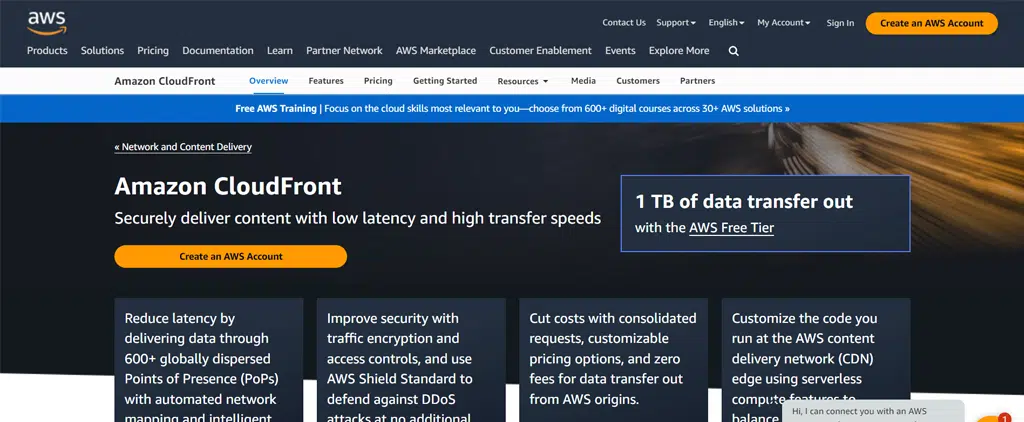
- Just like any CDN, CloudFront also operates through a global network of data centers called edge locations, ensuring low-latency content delivery.
- You can specify origin servers, such as Amazon S3 buckets or custom HTTP servers, from which CloudFront retrieves files for distribution.
- CloudFront supports the WebSocket protocol and various HTTP methods for efficient content delivery.
- It also allows customization of content delivery, serving private content from custom origins using Lambda@Edge functions.
- They use Enhanced content delivery by bringing more data closer to viewers through regional edge caches.
- Collaborates with AWS Shield, AWS WAF, and Amazon Route 53 to provide different layers of security against network and application layer attacks.
- Facilitates high deployment safety with blue-green environments, session stickiness, and performance monitoring for seamless updates.
- Can detect the country-level location of users for tailored responses and customization of content delivery.
Pros and Cons of Amazon CloudFront
Pros
- 600+ Points of Presence (POPs) in 100+ cities across 50+ countries
- Allows for customization of content delivery
- Easy Integration with AWS
Cons
- Less intuitive user-friendly interface
Pricing: Amazon CloudFront offers a No-Nonsense Free Tier plan, as well as premium Pay-as-You-Go plans that vary based on location and usage.
3. Google CDN
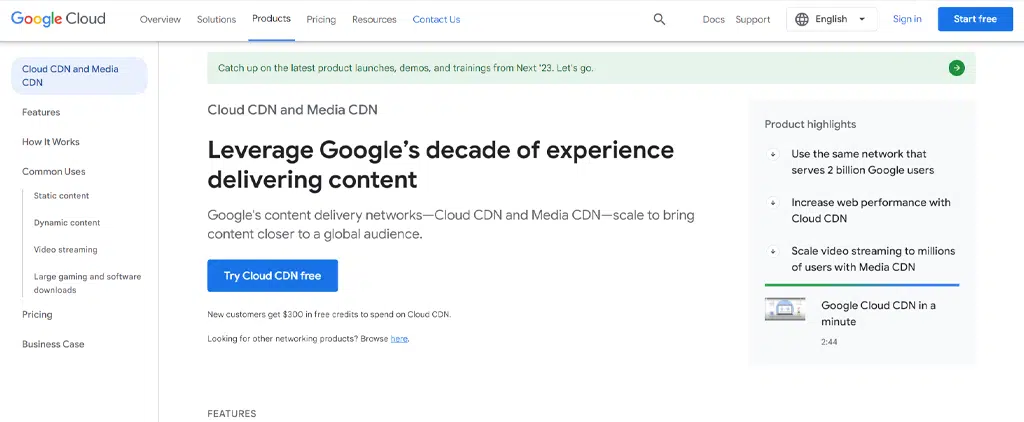
- Google Cloud CDN is a robust content delivery network (CDN) that leverages Google’s global edge network to serve content closer to users, enhancing website and application performance.
- It leverages Google’s global edge network for faster content delivery.
- It integrates with Cloud Armor for enhanced security against DDoS attacks.
- It offers configurable cache controls and dynamic compression for optimized content delivery.
- It Provides tools for real-time data insights and informed decision-making.
- New users can access $300 in free credits to explore Google Cloud CDN services.
Pros and Cons of Google CDN
Pros
- Google Cloud CDN uses Google’s Extensive infrastructure with 90 data centers to serve content closer to users.
- Integrated with the best security system Armour
- Offers configurable cache controls and optimizations like dynamic compression to help accelerate APIs and user-specific content.
- Provides real-time observability
Cons
- limited to only Google Cloud
- It may incur additional costs for users with content hosted on other clouds.
- It may not be as effective for users who need to integrate with non-Google services.
Pricing: New customers get $300 in free credits to spend on Cloud CDN and after that, you can go for pay-as-you-go plan.
4. CDN 77
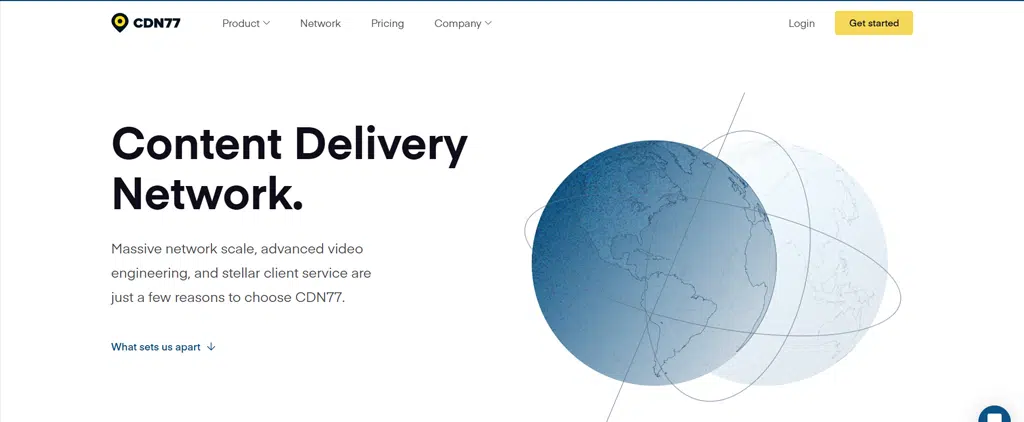
- The CDN77 is based in Los Angeles, California, and focuses on reducing latency for rich-content delivery.
- It is best known for its integration with WordPress, making it easier to distribute website content globally.
- It also shows positive reviews that highlight CDN77’s features, customer support, ease of use, and pricing, positioning it as a reliable CDN solution.
- Like any reputed CDN provider, the CDN77 also has a geographically distributed network of proxy servers and data centers that enhance website performance.
- It is also known to be among the first providers to offer features such as TLS 1.3, Brotli, or HTTP/2.
- Akamai Technologies has acquired the contracts of select SP//CDN enterprise customers and is assisting with their migration following the retirement of the SP//CDN service
Pros and Cons of CDN77
Pros
- It has 47 PoPs on 6 continents
- Efficient high-traffic flow management.
- Dynamic traffic load scaling.
- Complete control over asset delivery.
- Enhanced protection against cyber-attacks.
- Quick data transfer for faster website loading.
Cons
- Charges on CDN services can be significant, especially for large-volume traffic websites.
- Performance impact if server locations do not match audience geography.
- Complex issue resolution due to reliance on third-party infrastructures.
- No Free trial
Pricing: CDN77 doesn’t provide any Free trial and their plans start from $199 per month.
5. Imperva

- Imperva formally known as Incapsula is a comprehensive CDN provider that offers both security and
- It offers some best features like content caching, load balancing, failover mechanisms, enterprise-grade cloud web application firewalls, and DDoS protection.
- It has a Global network with Points of Presence (PoPs) present in 50 locations globally such as in North America, Europe, Asia-Pacific, Moscow, São Paulo, Tel-Aviv, and other regions.
- Imperva has very flexible enterprise licensing plans including Cloud WAF, Bot Protection, Attack Analytics, IP Reputation Intelligence, and a Content Delivery Network.
- It provides some of the best security features that includeToken authentication, geo-blocking, hotlink protection, basic authentication, two-factor authentication, and IP white/blacklisting.
- Any time technical assistance is provided via phone, email, or online self-service portal with a team of support engineers.
Pros and Cons of Imperva
Pros
- Provides intelligent caching controls for optimized content delivery.
- Enhances content and network optimization for improved performance.
- Offers application delivery rules for efficient content distribution.
- Ensures high website availability for uninterrupted user access.
Cons
- Costs may be high
- Complexity in utilizing advanced features
- Limited readily available information
Pricing: Imperva CDN offers a free trial along with premium plans starting from $0 to $299.
What is CDN?
CDN stands for Content Delivery Network, a network of servers distributed across various locations around the globe. These remote servers help deliver web content faster across nodes in the most effective manner, spanning various geographic locations from the origin of the web page to the content delivery server.
Whenever the network encounters a request, it is routed to the closest server, increasing the page load speeds. A CDN minimizes latency issues, resulting in a better experience for the user.
How does CDN work and improve website Performance?
- As we have already said, a CDN consists of a network of servers located in various geographical locations, which are known as points of presence (PoPs).
- The main purpose of a CDN is to minimize the physical distance between your website visitors and your website’s origin server.
- The CDN works by storing the content of your website such as images and stylesheets in the form of a cache and storing them on its edge servers located in various PoPs.
- When a visitor is trying to access the website or page, the CDN redirects the requests to a server that is nearby to the visitor’s location.
- For example, a website is hosted in Germany and the visitor is trying to access the website from the USA. In this particular case, the CDN will serve the website pages through the nearest local edge server in the USA.
- This way it boosts the website loading experience and the user’s request doesn’t have to go through such a long distance to reach the origin server.
What key features you should look into CDN for WordPress?
While selecting a CDN for your WordPress site, there are some key features you need to follow to get optimum performance and compatibility:
1. WordPress Integration: Always look for a CDN that offers easy integration with WordPress. For that, some CDNs have dedicated plugins or inbuilt integration options for WordPress sites which makes it easy and simple to set up.
2. Caching Options: A CDN should also offer various Caching Options such as full page caching, Object caching, object caching, and browser caching specially customized for WordPress sites. These options in the caching mechanism help to boost the website performance and decrease page load times by serving cached content to the users and reducing the origin server load.
3. Global Network of Servers: Prefer to choose only CDN with a large and geographically distributed network of servers. This helps to ensure quick content delivery to users across the globe, reducing latency and boosting the overall website performance.
4. SSL, HTTP/2, and HTTP/3 Support: Check whether the CDN supports SSL as well as the latest HTTP versions such as HTTP/2 and HTTP/3 protocol versions for Fast and secure data transmission between the server and the user’s browser or not. Because SSL is very crucial for protecting sensitive information and building trust.
5. Image Optimization: Images or Graphics used in WordPress websites can have a significant impact on website performance and also place a heavy load on the server. Therefore, many CDNs also offer image optimization features that automatically compress and resize images to reduce file sizes without compromising quality.
6. Analytics and Reporting: Check if the CDN provides you with detailed analytics and reporting tools to monitor website details such as traffic, performance metrics, and CDN usage. With the help of these data, you can optimize your website and find out the areas of improvement.
7. Security Features: A CDN should also offer robust and advanced security features to safeguard your website from various online threats such as DDoS attacks and hacking attempts. Look for features such as Web Application Firewall, DDoS mitigation, bot protection, etc.
8. Scalability: Make sure the CDN also offers scalability options so that when your website traffic grows, It can handle the sudden spike in traffic without impacting performance and stability.
9. Customer Support: Last but not least, do not forget to consider the Customer support provided by the CDN provider. Always choose CDN that offers responsive customer support, comprehensive guides, tutorials, and FAQs.
Why do you need to have CDN integrated with the WordPress site?
- Improved Website Performance: A CDN helps to distribute your website’s content across multiple servers worldwide, reducing the physical distance between your site’s visitors and its server. This results in faster loading times and improved performance for your WordPress site.
- Scalability: CDNs are designed to handle large amounts of traffic effectively. By offloading some of the server load to the CDN, your WordPress site can better handle spikes in traffic without experiencing downtime or slowdowns.
- Global Reach: With servers located in various geographic locations, a CDN ensures that your WordPress site can be accessed quickly from anywhere in the world. This is particularly beneficial if your site has an international audience.
- Enhanced Security: Some CDNs offer security features such as DDoS protection, web application firewalls, and SSL/TLS encryption. These help to protect your WordPress site from various online threats, ensuring the security and integrity of your content.
- SEO Benefits: Faster loading times and improved performance resulting from using a CDN can positively impact your WordPress site’s search engine rankings. Search engines like Google consider website speed as a ranking factor, so a faster site can potentially lead to higher visibility in search results.
- Bandwidth Savings: By caching and serving static content from edge servers, a CDN reduces the bandwidth usage of your WordPress hosting server. This can lead to cost savings, especially if your hosting plan includes bandwidth limitations or if you pay for bandwidth usage.
Pros and Cons of CDN
To get a better idea of How CDN can be beneficial for you and what are its shortcomings, check out their pros and cons.
Pros of CDN
- Bring down the server load: Due to the strategic placement of the servers across the globe, the size of each request can be taken down by a lot, as the content is spread out on various servers rather than just dumping all the content on one big server.
- Decreased Latency and packet data loss: As the various servers are spread out and are near the prospective user groups, the time taken to complete each request is reduced.
- 100% site up time: If one of the servers goes down or encounters any problem, this will not lead to the site going down and becoming unavailable. The network would sense this and point the request to the next closest server.
- Increased Concurrent Users: Strategical placement of servers can provide a high network backbone capacity, which could mean a higher number of users that can concurrently access the network.
Cons of CDN
- Cost: The biggest drawback of CDN is undoubtedly the price factor. A CDN has high setup fees along with other hidden charges, which make it very difficult for a small company to make use of it.
- Impractical: The concept of CDn itself is a very complex one by nature and hence it is very difficult to set up and get to work properly for all users all across the globe.m Also the maintenance of such a network can be extremely difficult and might require a small team on itself.
- No Direct Control: If any changes are to be made to the site, it has to be made through the CDN provider and can not be made directly. This could cause problems for editors and developers.
Top 5 CDN providers (Running Tests and Comparison)
We are using a WordPress 6.4 website, with around 200 posts and 200 attachments. The WordPress site is running on a Nginx server with PHP 8.1.
A. Test 1: WebpageSpeed Test
In this test, the same site will run on the web page performance test on http://www.webpagetest.org/. The site will be tested from 4 different locations across the globe and the time from all the locations and the average Load time for all locations will be compared. Another parameter in which we are interested is the ‘First Byte‘ time. The site is hosted on a server in Dallas, Texas. This test will be conducted from 4 locations :
- San Jose
- New York
- Amsterdam
- Sydney
A.1. Load Time & Time to first byte (San Jose)
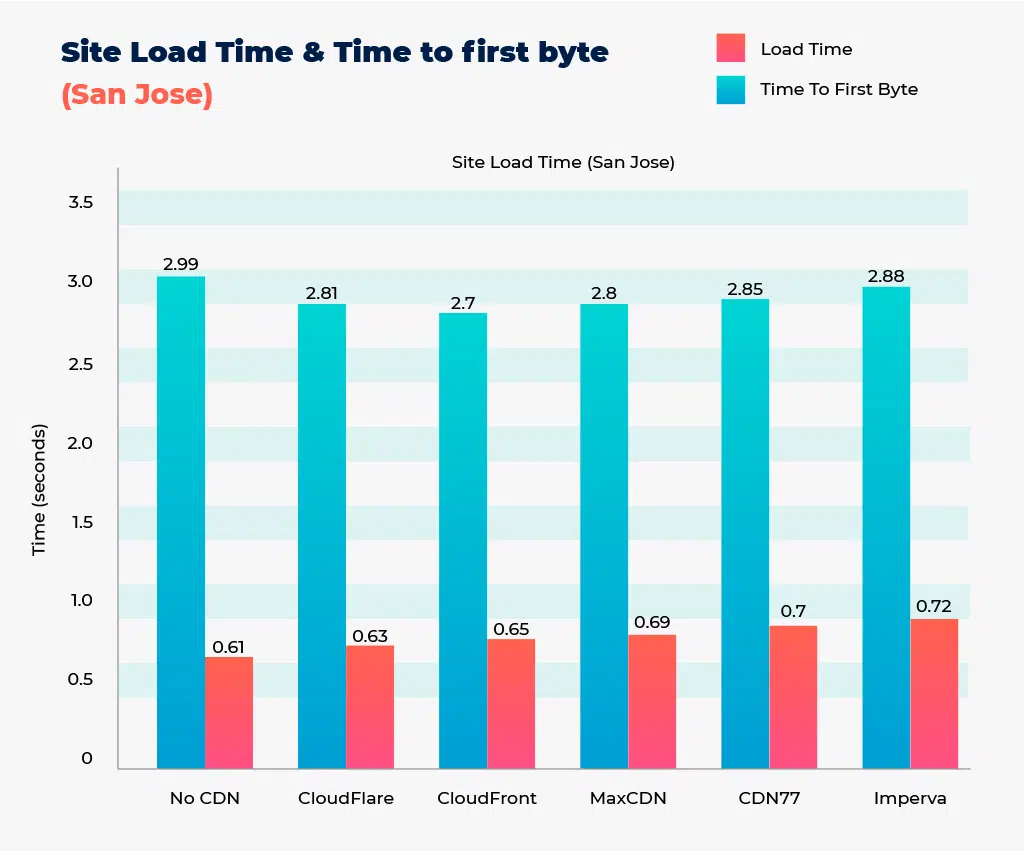
A.2. Load Time & Time to the first byte (New York)
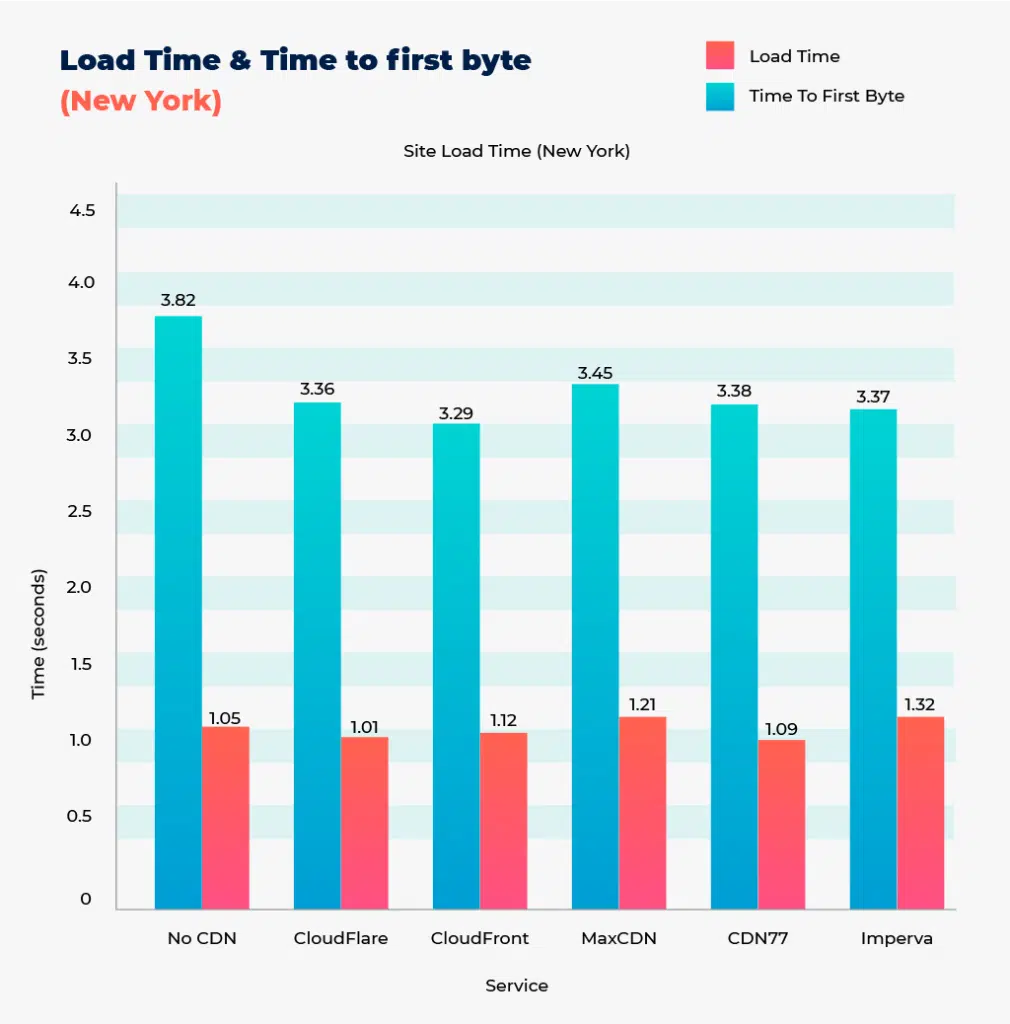
A.3. Load Time & Time to first byte(Amsterdam)
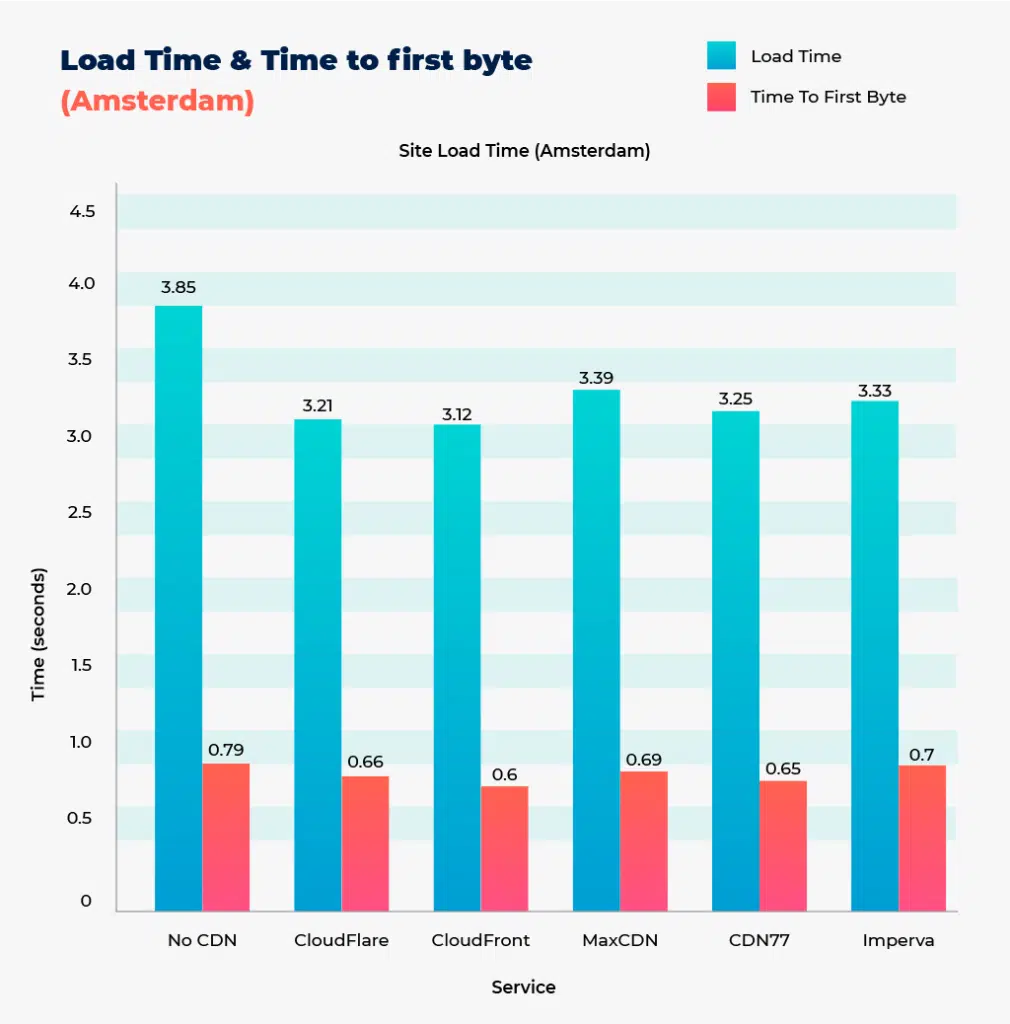
A.4. Load Time & Time to first byte (Sydney)
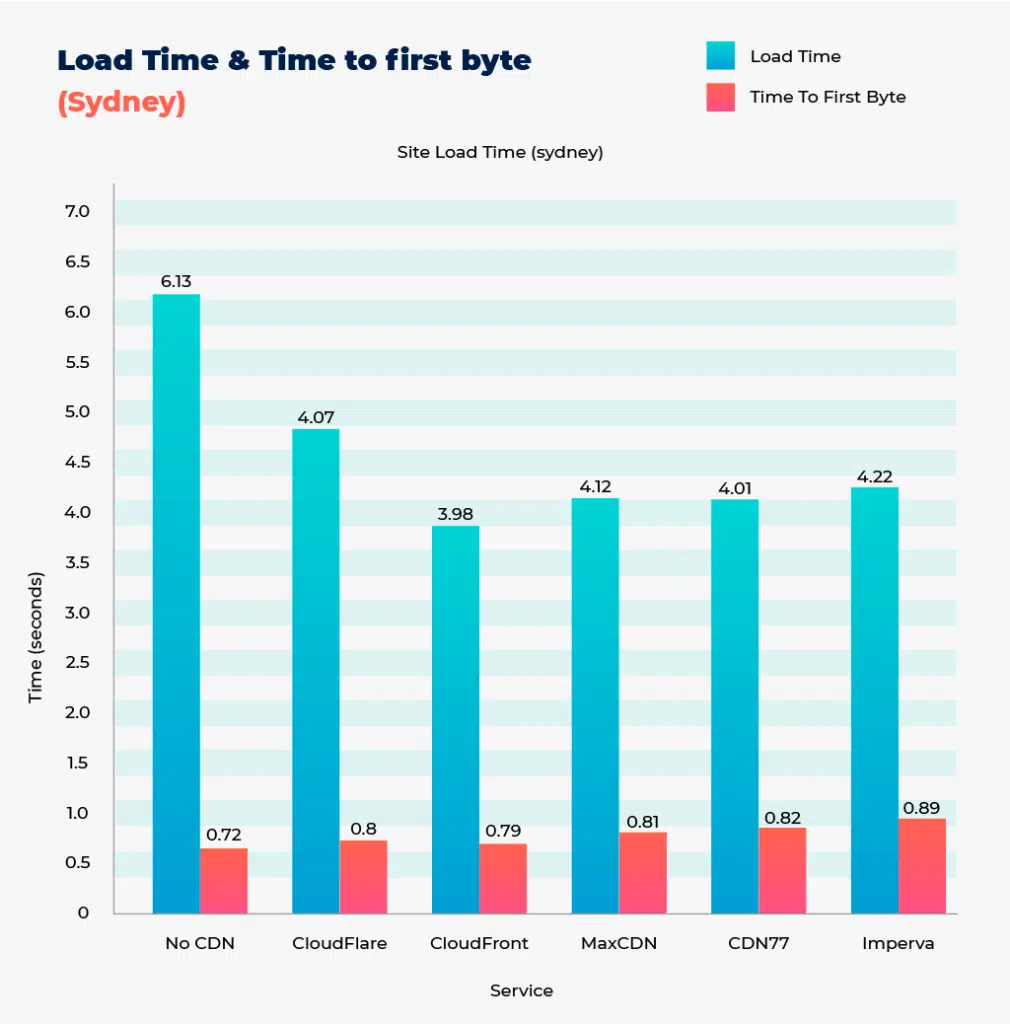
A.5. Overall Average Load Time & TTFB of all locations
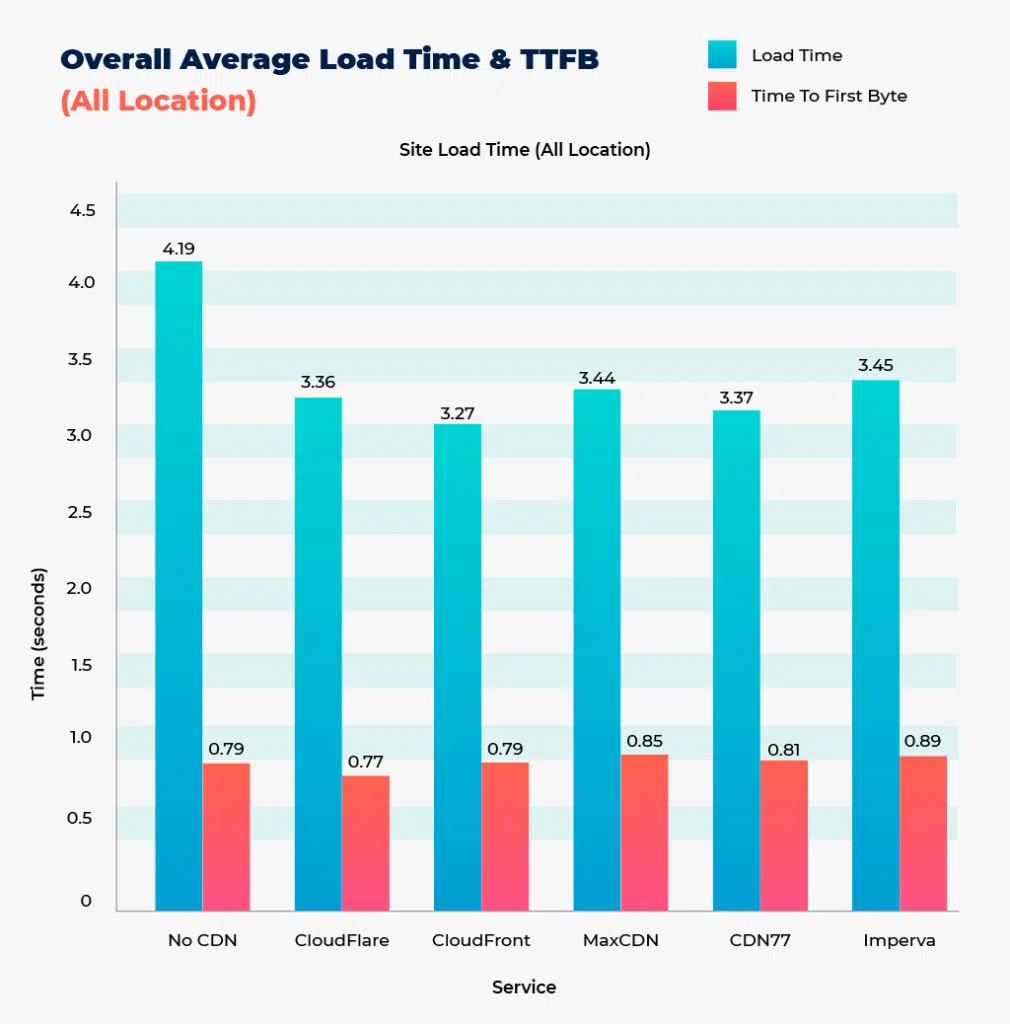
Since the server on which our test site is hosted, is located in Dallas, we see there isn’t much difference in the Load times between CDN-enabled and non-CDN-enabled tests, but as we test from different continents we see this gap increase a lot. This stress on one of the main benefits of a CDN.
The results clearly show that CloudFlare, CDN77, and Amazon CloudFront have performed better than the other services in terms of load time.
B. Test 2: Load Test
The second test is an application load test on http://loadstorm.com/. This will test the site for 10 concurrent users sending requests to the site over 10 minutes. From this test, we will look into the ‘Requests per second‘ and the ‘Response time‘ parameters for each CDN.
B.1. Requests Per Second
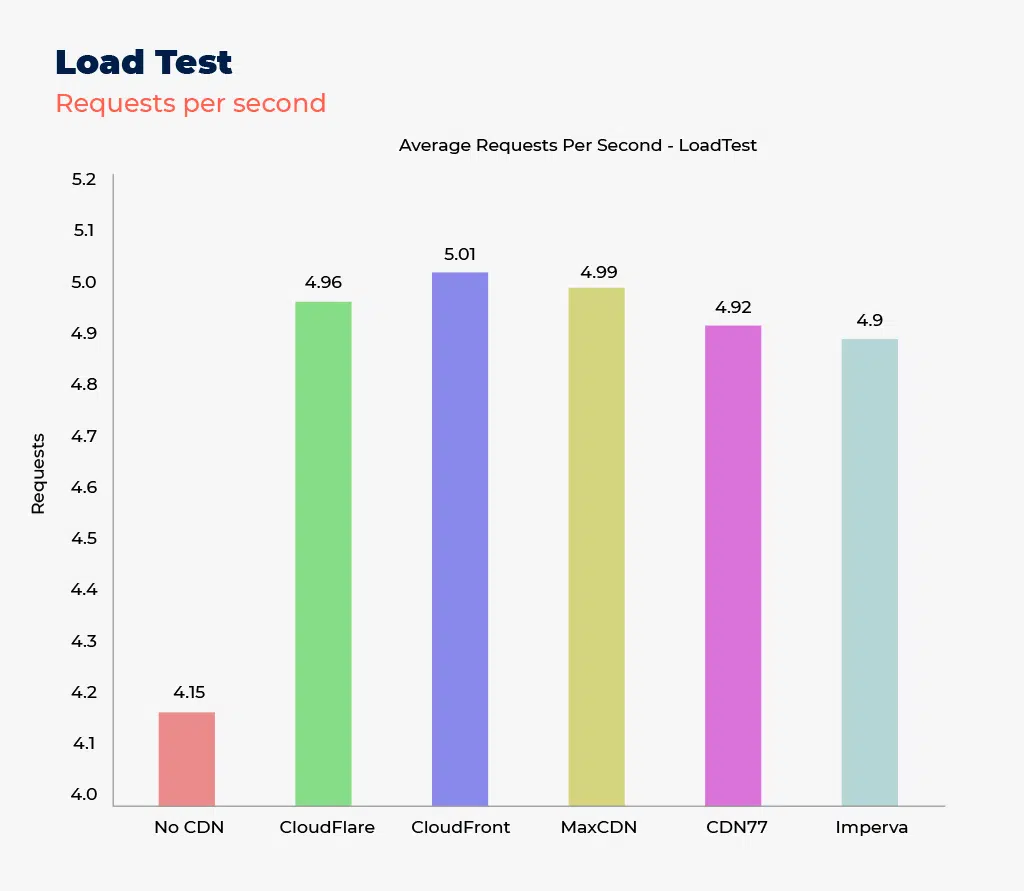
We can see that the CDNs perform much better than the sites running without CDNs. All the CDNs performed almost similarly in this test with Amazon CloudFront having just a slight edge.
B.2. Average Response Time
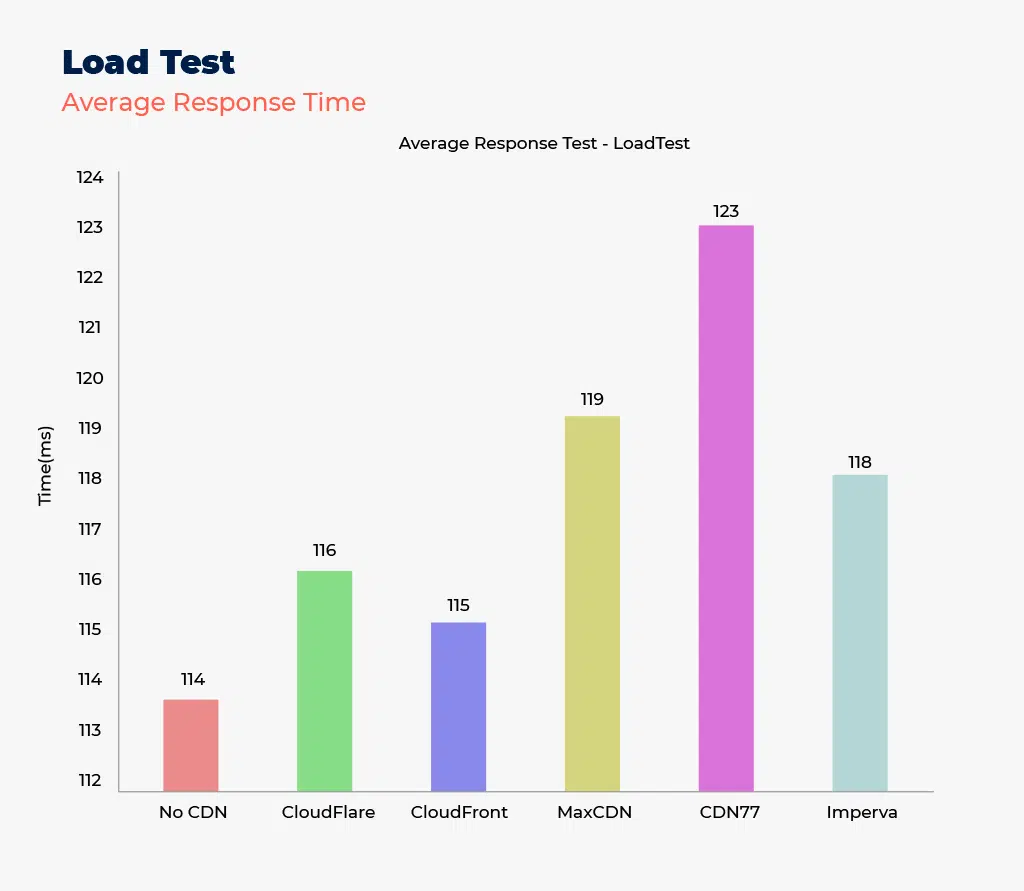
The Average response time result may look surprising but it shows a high value for the CDNs because almost all the CDN providers gave a very high Peak Response time value. This was right at the start of the test, but once that stabilized, the response times were less than those of the site running without CDN.
Again in this test, we see that CloudFlare and Amazon Cloudfront did better than the other services.
Conclusion – Top WordPress CDN
In both tests, you can see that the numbers tell the truth, with almost all CDNs performing equally well. However, Cloudflare and Amazon CloudFront performed slightly better than the others. Additionally, Cloudflare is extremely popular, with many web hosting companies offering this service for free in their web hosting plans.
Even WPOven is not behind; it is also a proud partner of Cloudflare and offers free Cloudflare service with every plan.
Now you will be able to choose the right one, won’t you?
Frequently Asked Questions
Can a CDN provider improve website security?
Yes, CDN provides exceptionally in providing robust and best security features like WAF, DDoS protection, SSL/TLS, and bot mitigation. These security measures help protect websites from cyber threats, ensuring secure, reliable, and speedy content delivery.
Who are the major CDNs?
Some major CDN providers include:
1. Cloudflare
2. Amazon CloudFront
3. Google CDN
4. CDN77
5. Imperva
These providers offer a range of services and features to accelerate website performance, enhance security, and ensure reliable content delivery to users globally.
Can I switch CDN providers?
Yes, you can switch to any other CDN provider anytime if you want.

I am a Co-Founder at WPOven INC currently living in Vancouver, Canada. My interests range from Web Development to Product development and Client projects. I am also interested in web development, WordPress, and entrepreneurship.

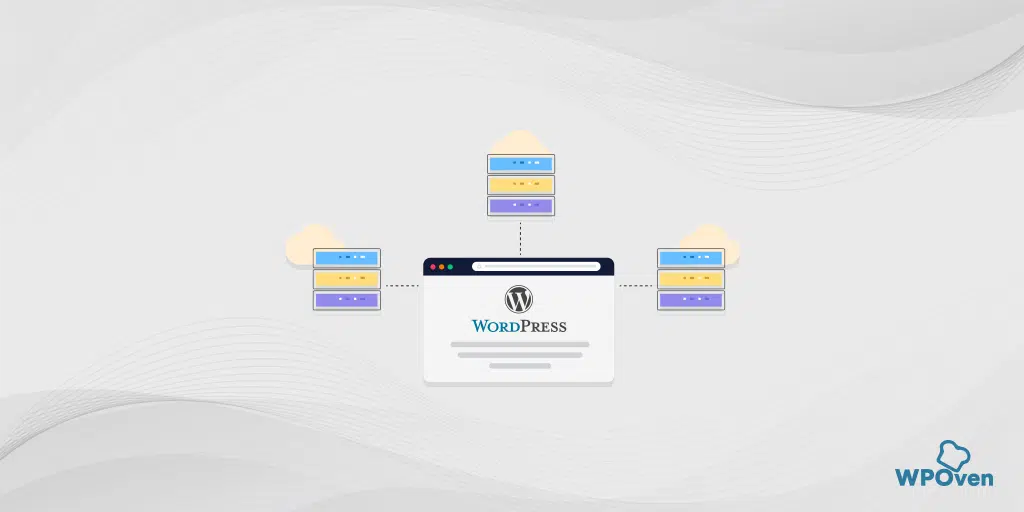
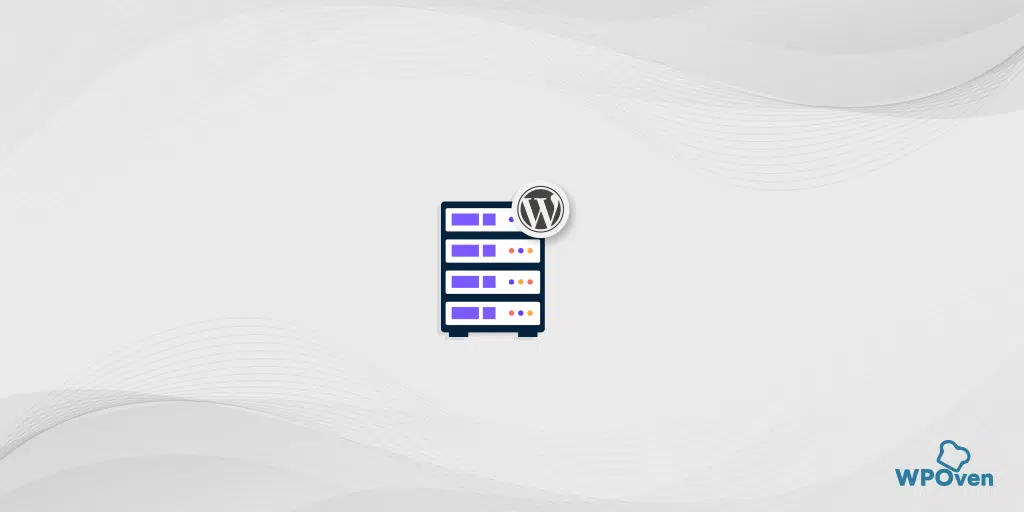
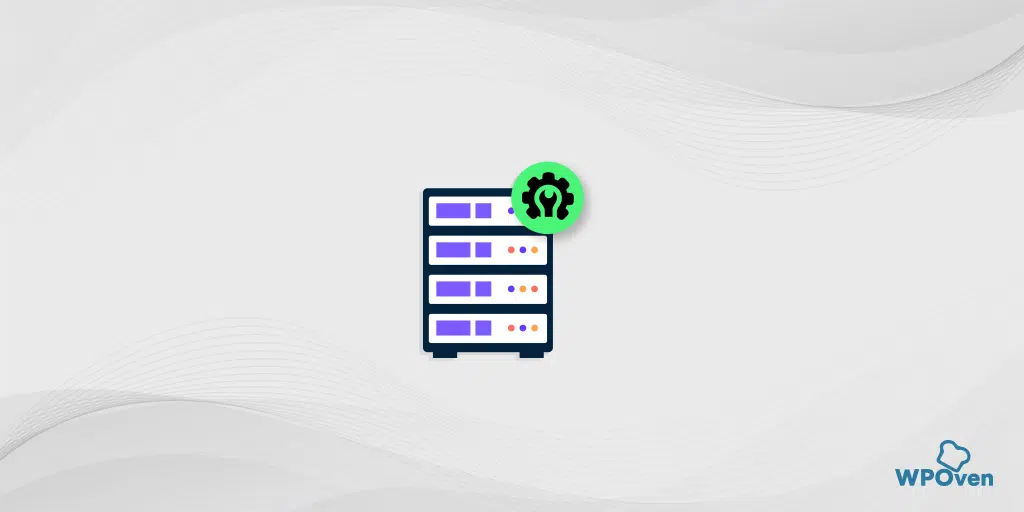
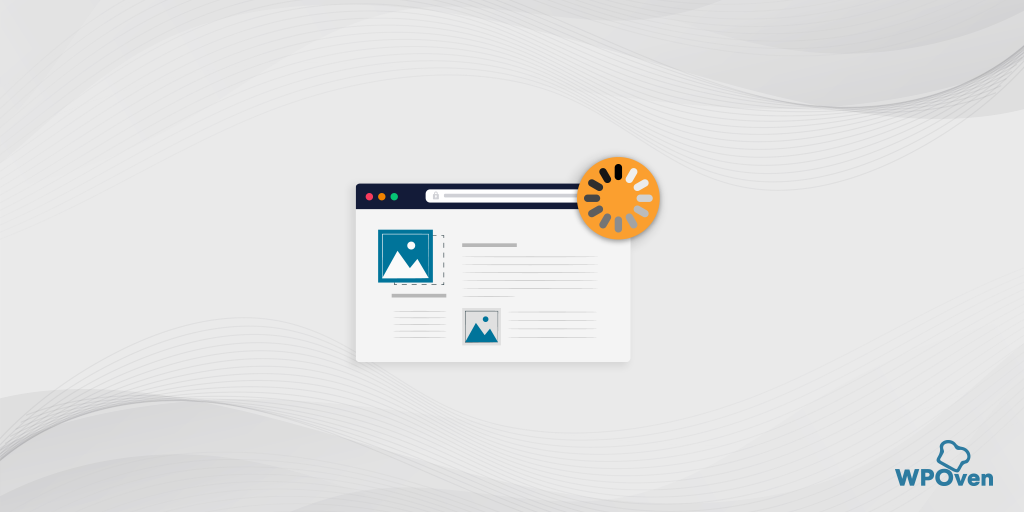
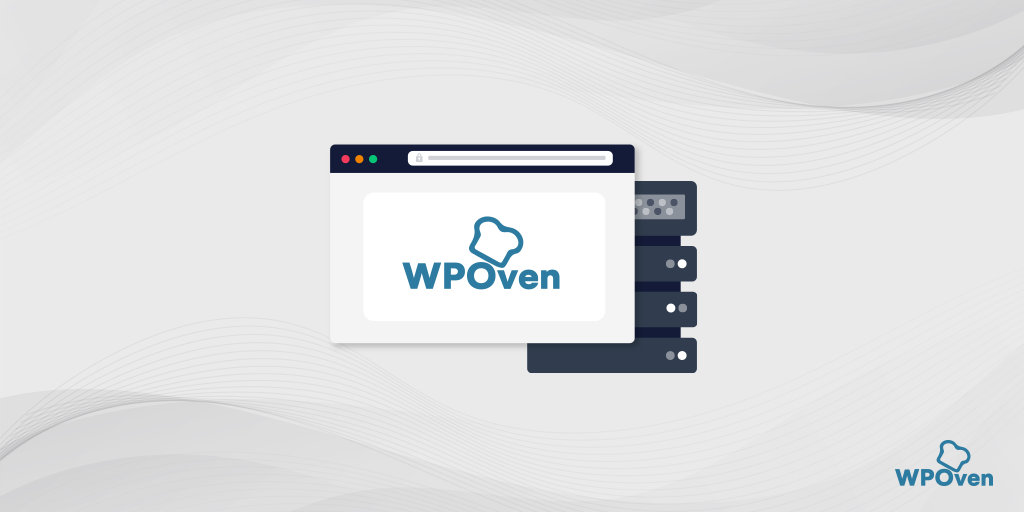
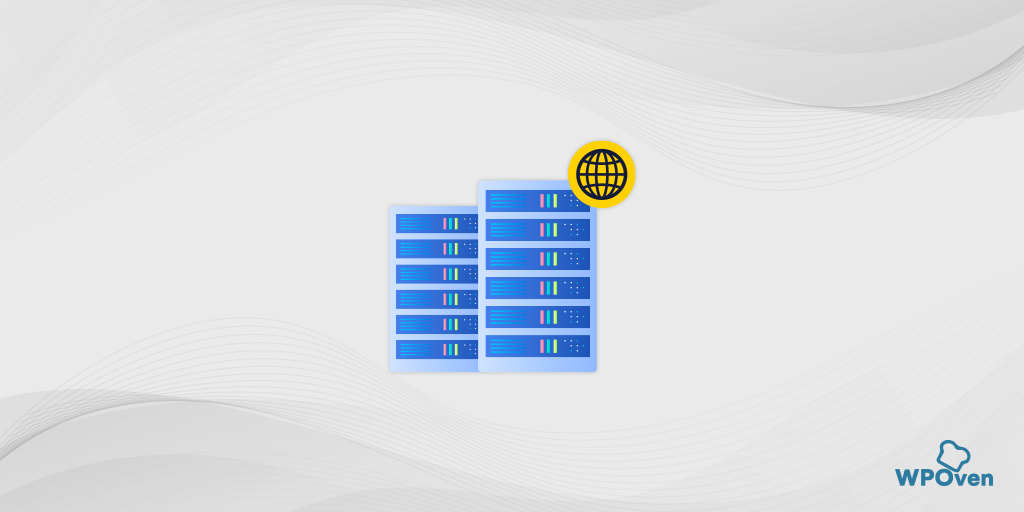
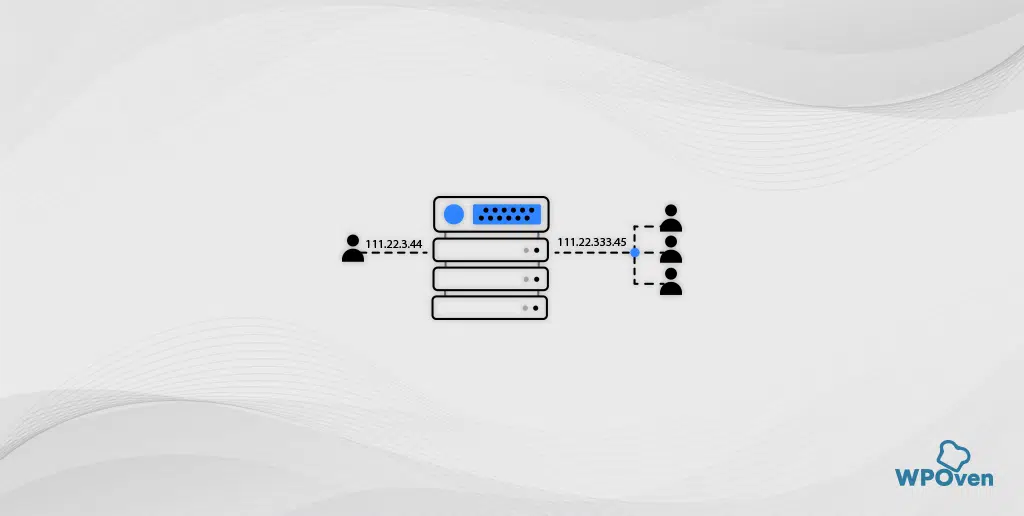

Ummm….
“CDN stands for Content Management System.”
Bit of an epic typo there!
Hey John
Thanks for bring it to my notice. Has been updated
🙂
Hey,
But if you move the EXISTING pictures from WordPress to a new external CDN, do you then know of an easy way to migrate all the existing links that are already posted all over the blog? Even more, some of those services will create internal paths and file names, so there’s no way to map existing pictures in WordPress with the same file in the new location…
Or can you think of a way to achieve this migration?
WordPress is an open source Content Management System, which allows users to build dynamic websites. WordPress tutorial is the most popular blogging system.